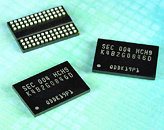Monday, February 1st 2010

Samsung Develops Most Advanced Green DDR3 DRAM, Using 30nm-class Technology
Samsung Electronics Co., Ltd., the world leader in advanced semiconductor technology solutions, today announced that the industry's first 30-nanometer-class DRAM has just successfully completed customer evaluations, in two gigabit (Gb) densities. With DDR3 SDRAM becoming the predominant main memory this quarter, Samsung's aggressive advancement in process technology will raise productivity and expedite dissemination of high performance, 1.5V and 1.35V DDR3 for servers, desktops and notebook PCs.
"Our accelerated development of next generation 30nm-class DRAM should keep us in the most competitive position in the memory market," said Soo-In Cho, president, Memory Division, Samsung Electronics.He added, "Our 30nm-class process technology will provide the most advanced low-power DDR3 available today and therein the most efficient DRAM solutions anywhere for the introduction of consumer electronics devices and server systems."
The 30nm-class process when applied to DDR3 mass production raises productivity by 60 percent over 40nm-class DDR3. This will result in a doubling of production cost-efficiency compared to DRAM produced using 50nm to 60nm-class technology.
The 30nm-class 2Gb, Green DRAM reduces power consumption by up to 30 percent over 50nm-class DRAM. A 4-Gigabyte (GB), 30nm module when used in a new-generation notebook will consume only three watts per hour, which is just three percent of the total power usage of a notebook.
The new DDR3 will be used in a broader range of products, from servers to notebooks, desktops, and future versions of netbooks and mobile devices.
The 30nm-class DDR3 is scheduled for mass production in the second half of this year.
"Our accelerated development of next generation 30nm-class DRAM should keep us in the most competitive position in the memory market," said Soo-In Cho, president, Memory Division, Samsung Electronics.He added, "Our 30nm-class process technology will provide the most advanced low-power DDR3 available today and therein the most efficient DRAM solutions anywhere for the introduction of consumer electronics devices and server systems."
The 30nm-class process when applied to DDR3 mass production raises productivity by 60 percent over 40nm-class DDR3. This will result in a doubling of production cost-efficiency compared to DRAM produced using 50nm to 60nm-class technology.
The 30nm-class 2Gb, Green DRAM reduces power consumption by up to 30 percent over 50nm-class DRAM. A 4-Gigabyte (GB), 30nm module when used in a new-generation notebook will consume only three watts per hour, which is just three percent of the total power usage of a notebook.
The new DDR3 will be used in a broader range of products, from servers to notebooks, desktops, and future versions of netbooks and mobile devices.
The 30nm-class DDR3 is scheduled for mass production in the second half of this year.

8 Comments on Samsung Develops Most Advanced Green DDR3 DRAM, Using 30nm-class Technology
Less voltage does pretty much co-relate to less heat, actually.
You're thinking that the chip will be hotter due to being the same amount of heat in a smaller area, but its producing less heat due to the shrink, as well as lower voltage. Higher temperature does not equal less heat output, and this is likely to have lower heat output, AND lower temperature.
Sorry, but that logic is flawed. The smaller, the better, the faster, the cooler. That's how it goes in the semi-conductor world.
Otherwise a 32nm Hex-Core would burn through the floor the way you're thinking.
If the heat output is constant and the surface area decreases, the temperature increases (adding a heatsink, in reverse - less metal, higher temps)
Its true in a basic logic sort of way, but its faulty logic. The power consumption goes down, so the heat output goes down as well. You dont get die shrinks without lower power requirements - its the main benefit of shrinking them down.
same speed, large size = more voltage, more heat ouput
same speed, smaller size = less voltage, less heat output
TAViX must've been confused with the smaller size but with the same power requirements(?)